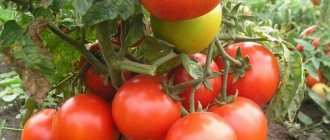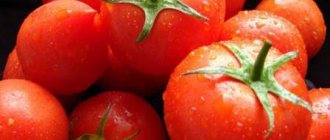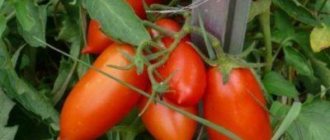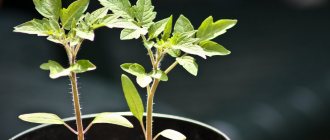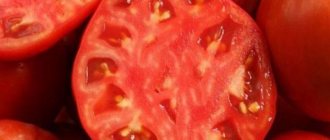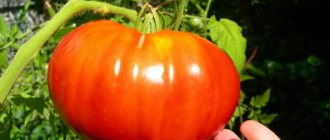Botanical description
Characteristics and description of the Benito tomato variety:
- mid-early maturation;
- from the appearance of sprouts to the harvesting of fruits, it takes from 95 to 113 days;
- height 50-60 cm;
- determinate bush;
- large drooping leaves;
- 7-9 tomatoes ripen per bunch.
Features of the fruits of the Benito variety:
- plum-shaped elongated shape;
- red when ripe;
- average weight 40-70 g, maximum – 100 g;
- pronounced tomato taste;
- dense pulp with a small number of seeds;
- thick skin;
- dry matter content – 4.8%, sugars – 2.4%.
The yield of the Benito variety is 25 kg per 1 m2 of planting. The fruits are stored for a long time and can withstand long-term transportation. They are picked green at the stage of technical maturity. Tomatoes ripen quickly in room conditions.
Benito tomatoes are used for home canning: pickling, pickling, pickling. When cooked, the fruits do not crack, so they are suitable for whole-fruit canning.
Productivity
The tomato variety is capable of producing a harvest of 3-4 kg per bush, which has the shape of a ball and occupies 50 cm of open ground.
It has a large number of fruits per bush, on average 20 oblong-shaped fruits. This result, as a rule, is considered quite profitable for any farmer, and has its advantages among the agricultural crop of tomatoes, both hybrid and traditional types. The Benito tomato culture can withstand the harshest growing conditions, and is not considered a crop that is picky about soil or climatic conditions. This tomato variety is resistant to weather conditions and has fairly stable fruit ripening periods. The plant variety is considered a later type of tomato, which is why it has a fairly strong root and carpal system that can withstand up to 10-15 degrees plus.
The root system of the Benito tomato variety is quite strong and can withstand up to 10-15 degrees plus
Thanks to this hybrid, a farmer who is seriously developing tomatoes has the opportunity to harvest 2 harvests during the entire sowing period. Indeed, in the south, this crop can retain its shape until October inclusive. In order to harvest on time, it is necessary to count the days until full ripening. When the first stems appear, at least 85 days must pass from seed to full ripening.
There is a classification of the percentage of pulp in the Benito fruit, they range from 4 to 5%, which indicates a product with a thick and strong peel. It is able to independently get rid of a number of pests, as well as maintain its shape in a more elastic form.
Characteristics of tomato variety "Benito"
The percentage of sugar in a product plays an important role. This variety contains 2-2.5% sugar per 100 grams of product. The taste of this hybrid is sweet. You can also determine the ripeness of the fruit by taste, because the green tomato of this variety has a sour taste, reminiscent of a wild plum. The ripe fruit is quite sweet and is widely used in culinary dishes.
Obtaining seedlings
Benito tomatoes are grown in seedlings. Seeds are planted at home. The resulting seedlings are provided with temperature conditions and watering. Grown tomatoes are transferred to a permanent place.
Planting seeds
Benito tomatoes are planted in prepared soil. It can be obtained by mixing an equal volume of fertile soil and compost. An alternative option is to purchase peat tablets or ready-made soil mixture.
The soil is treated by heating in an oven or microwave oven. After 2 weeks, planting work begins. Another way to treat the soil is to water it with a solution of potassium permanganate.
Advice! Before planting, Benito tomato seeds are kept in warm water for 2 days to improve germination.
If the seeds have a colored shell, they do not need additional processing. The manufacturer covered the planting material with a nutrient mixture from which the plants will receive energy for development.
Containers up to 15 cm high are filled with moistened soil. Benito tomatoes are planted in boxes or separate containers. The seeds are placed at intervals of 2 cm and covered with fertile soil or peat with a layer of 1 cm.
Containers with plantings are kept in a dark place. Seed germination is directly affected by room temperature. In warm weather, seedlings will appear a few days earlier.
Seedling care
Benito F1 tomato seedlings are provided with the necessary conditions:
- Temperature. During the daytime, tomatoes are provided with a temperature range from 20 to 25°C. At night the temperature should remain between 15-18°C.
- Watering. Benito tomato seedlings are watered as the soil dries using a spray bottle. Warm water is sprayed over the soil, preventing it from getting on the stems and leaves of plants.
- Ventilation. The planting area is regularly ventilated. However, drafts and exposure to cold air are dangerous for tomatoes.
- Lighting. Benito tomatoes need good lighting for 12 hours. When daylight hours are short, additional lighting is required.
- Feeding. Seedlings are fed if they look depressed. For 1 liter of water take 2 g of ammonium nitrate, double superphosphate and potassium sulfate.
2 weeks before planting, tomatoes are hardened in the fresh air. The seedlings are transferred to the balcony or loggia. At first it is kept for 2-3 hours a day. Gradually, this period is increased so that the plants get used to natural conditions.
Description of the tomato variety Cetus pink, its characteristics and yield
The pink Cetus tomato is the development of Italian breeders, but in a short time it has become popular in Russia. Thanks to its strong survival qualities, today the variety is grown in various Russian regions. When breeding an indeterminate species, the goal was to combine excellent taste characteristics and high yields. The advantages of the new type are:
- high yield;
- rich tomato taste, which compares favorably with most traditional types;
- early fruit ripening;
- resistance to major tomato diseases;
- ability to withstand low temperatures and heat.
A distinctive quality of the new type is the unusual taste of vegetables, the content of vitamins in which is several times higher than traditional red tomatoes.
Description of tomatoes
Tomatoes have a characteristic round shape with a slight flatness. The fruits of the Cetus pink tomato have dense pulp and a rich crimson color. When cutting the vegetable, you can observe a bright pink tint.
From 6 to 8 fruits are formed in one brush. The inflorescences tolerate stress well and are able to maintain good setting properties even in difficult climatic conditions. Even the first brushes are capable of producing at least 5 tomatoes. Vegetables have a beautiful appearance and special color.
The average weight of vegetables reaches from 250 to 270 grams. By controlling the size of the clusters, it is possible to obtain fruits of 300 grams.
Thanks to their dense structure, the fruits are well stored and can withstand long-term transportation. Vegetables retain their aesthetic qualities and do not crack during storage.
Features of care
The height of the shoots reaches 2 meters, so the plant needs to be tied up. At the same time, the shoots combine tall growth and compactness. The bushes have a small number of leaves and short internodes, which makes caring for the plant easier.
The plant has a developed root system, therefore it does not require watering and is able to provide the shoots with a sufficient amount of nutrients. This ability makes it possible to increase the yield by 20% compared to traditional varieties. The ability to grow the variety year-round in glass structures is considered a strong quality.
The plant is grown in seedlings and begins to bear fruit 60–65 days after the appearance of the first shoots. If the growing rules are followed correctly, a plant can produce up to 25 kg of vegetables per 1 m². When planting seeds in March, the first fruits are harvested in July. A short rotation allows you to produce 4–6 clusters with smaller fruit size; the yield in this case does not exceed 15 kg per 1 m².
When planting, it is important to maintain the recommended distance between bushes. Caring for the plant consists of timely watering, removing weeds and providing support for the shoots by tying them up
Landing in the ground
Benito tomatoes are transferred to a permanent place when the seedlings reach a height of 30 cm. Such seedlings have 6-7 full leaves and a developed root system. Planting is done when the air and soil in the beds are well warmed up.
Preparing the soil for tomatoes begins in the fall. The planting site is chosen taking into account the previous crop. Tomatoes grow best after root vegetables, green manure, cucumbers, cabbage, and pumpkins. After any varieties of tomatoes, peppers, eggplants and potatoes, planting is not performed.
Advice! In the fall, the beds for Benito tomatoes are dug up and fertilized with humus.
In the spring, deep loosening is done and holes are prepared for planting. Plants are spaced in 50 cm increments. In the greenhouse, Benito tomatoes are planted in a checkerboard pattern to simplify care and avoid increased density.
The seedlings are transferred to a new place together with a lump of earth. The soil under the tomatoes is compacted and the plants are watered abundantly. It is recommended to tie the plants to a support at the top.
We characterize this culture
This variety of tomatoes has already received recognition from experts. It most often has positive reviews from both gardeners and consumers. The culture was bred by Russian breeders in the current century.
The described tomatoes are intended for cultivation throughout Russia, as well as in neighboring Moldova and Ukraine. After the seeds are planted in the ground and until the moment when the tomatoes should fully ripen, it usually takes a little more than ninety days, a maximum of one hundred, therefore, “Honey Cream” refers to the early ripening species.
This variety of tomatoes has already received recognition from experts. It most often has positive reviews from both gardeners and consumers. The culture was bred by Russian breeders in the current century.
Care procedure
Benito tomatoes are cared for by watering, fertilizing, loosening the soil and pinching. According to reviews, Benito F1 tomatoes produce a high yield with constant care. The bush is compact, which makes harvesting easier.
Watering
Tomatoes are watered every week with 3-5 liters of water. The procedure is performed in the morning or evening hours, when there is no direct sun exposure.
The intensity of watering depends on the stage of development of tomatoes. The first watering will be required 2-3 weeks after planting. Before the inflorescences form, the tomatoes are watered weekly with 4 liters of water.
When flowering, Benito tomatoes require more moisture. Therefore, 5 liters of water are added under the bushes every 4 days. During fruiting, excess moisture leads to cracking of the fruit. When the fruits ripen, weekly watering is sufficient.
The moistened soil is carefully loosened so as not to disturb the root system of the plants. Loosening improves air exchange in the soil and the absorption of nutrients.
Top dressing
Benito tomatoes need regular feeding. Mineral or organic fertilizers are used as fertilizers. Fertilizing is combined with watering the plants.
During the season, Benito tomatoes are fed several times. The first feeding is carried out 10-15 days after planting the tomatoes. Organic fertilizer is prepared for it, consisting of mullein and water in a ratio of 1:10. The tomatoes are watered with the solution at the root.
After 2 weeks, the tomatoes are fed with minerals. For 1 sq. m requires 15 g of superphosphate and potassium salt. Substances are dissolved in water or applied to the soil in dry form. A similar feeding is carried out after 2 weeks. It is better to avoid using mullein and other nitrogen fertilizers.
During the flowering period, Benito tomatoes are treated leaf by leaf with boric acid-based fertilizer. 2 g of the substance is dissolved in 2 liters of water. Spraying helps increase the number of ovaries.
Important! When fruits are formed, plants are repeatedly treated with potassium and phosphorus solutions.
You can replace minerals with wood ash. It contains calcium, phosphorus, magnesium and other substances necessary for the development of tomatoes. Ash is added to the soil or infused for further watering.
Bush formation
According to its description and characteristics, the Benito tomato variety belongs to determinate varieties. Tomatoes of these varieties form 1 stem. Stepchildren growing from the leaf axil are torn off by hand.
Stepping allows you to avoid thickening and get a high yield. The procedure is carried out every week.
Protection from diseases and pests
The Benito variety is resistant to viral mosaic, verticillium and fusarium. To prevent diseases, monitor the humidity level in the greenhouse and treat the plants with fungicides.
Tomatoes attract aphids, gall midges, mole crickets, whiteflies and other pests. Insecticides help fight insects. To prevent the spread of pests, plantings are treated with tobacco dust or wood ash.
Pests and diseases: control and prevention measures
Tomatoes of the "Benito" variety are quite resistant to major diseases , but sometimes troubles happen.
Spraying plantings with copper-containing preparations will help prevent late blight. Treatment with phytosporin, as well as frequent ventilation, loosening or mulching of the soil will protect against rot. Black wedding dress - a stunning luxurious challenge to tradition (88 photos)
Insect pests harm tomatoes at all stages of plant development. Seedlings are threatened by thrips and aphids, adult bushes are attacked by slugs, Colorado potato beetles and mole crickets. Plantings need to be inspected regularly in order to detect uninvited guests in time.
Aphids are washed off with warm soapy water, and flying insects are destroyed using insecticides. Decoctions of herbs also help: celandine, yarrow, chamomile.
The tomato variety “Benito F1” will be an interesting find for lovers of medium-sized sweet fruits. It will also appeal to gardeners planning to start canning. The only problem common to all hybrids is the inability to collect seeds for future sowing in your own beds.
Reviews from gardeners
Valentina, 48 years old, Volgograd
I bought Benito seeds at a flower shop. The seeds sprouted quickly, the seedlings developed well and did not get sick. I grow all my tomatoes in a greenhouse, including this variety. The tomatoes grew strong, about 80 cm high. A lot of ovaries were formed. The fruits are on average 100 g, elongated in shape.
Evgeniya, 62 years old, Chelyabinsk
I planted the variety Benito on the plot last year. The tomatoes have grown short and are easy to care for. All the bushes were hung with fruits. The shape of tomatoes resembles a plum. They go well for homemade preparations and do not crack when salted. Next year I plan to allocate more space for this variety.
Vitaly, 34 years old, Saratov
Based on reviews, we purchased Benito F1 tomatoes for planting at our parents’ dacha. The tomatoes grew in a greenhouse, but it was not closed all summer, only in rain and cold winds. A huge number of fruits grew on low bushes. They were light in weight, but the taste was great. The harvest was harvested in mid-August. The tomatoes lasted until November.
Advantages and disadvantages of the Benito f1 hybrid
Neither amateurs nor professional gardeners found any shortcomings in this variety.
The only negative that is worth mentioning is the infection of the plant with stolbur.
There are many more positive qualities:
- high fruiting;
- excellent taste;
- ease of cultivation;
- transportability and long shelf life;
- successfully used in agricultural enterprises and small garden plots.
The peculiarity of Benito F1 is that it continues to bear fruit until the first frost. On the hundredth day, a bountiful harvest is harvested, and subsequently the number of fruits decreases significantly, but does not stop.
What is a Benito tomato?
Characteristics and description of the variety:
- plum-shaped, elongated shape;
- the ribbing on the fruit is weakly expressed in the area of the stalk;
- tomato bushes Benito f1 look decorative on the site;
- the variety is appreciated by gourmets of fresh vegetables for its excellent taste;
- mid-season variety;
- determinate, standard plant;
- during growth, the bushes gain a little green mass with simple leaves;
- Benito tomatoes ripen in clusters; 5-7 fruits are formed on each branch;
- from 1 bush you can get up to 8 kg of tomatoes.
Tomato Benito fruit description has the following:
- the weight of 1 fruit varies from 100 to 140 g;
- ripe fruits are deep red in color;
- tomatoes are covered with thick, glossy skin, which is elastic;
- the skin does not crack during ripening and transportation, so the Benito variety is suitable for transportation over long distances;
- The fruits are sweet to taste; without water;
- contains a large amount of dry matter and sugars;
- the pulp inside the fruit is dense; few seeds.
The description of the Benito tomato should be supplemented by the fact that the variety is excellent for growing in open soil, in film greenhouses, shelters and greenhouses. Reviews from gardeners indicate that this type of tomato grows well and bears fruit in the Far East, the Urals, and Siberia.
The variety demonstrates excellent keeping quality. If green fruits are picked and placed in boxes, they will ripen at room temperature. Benito tomatoes are used to make soups, sauces, purees, and salads. Many people eat the delicious fruits fresh or as part of other dishes. Benito can also be used to decorate sandwiches.
Ripe tomatoes can be used to make tomato juice, which will have a rich taste and consistency. The fruits are excellent for canning; they do not crack when hot marinade is poured into jars.
Advantages of the Benito tomato:
- excellent taste;
- no need to tie it to supports;
- suitable for preparing various tomato dishes;
- resistant to such types of nightshade diseases as mosaic, fusarium, verticillium.
Application
You should start growing seeds from the beginning of March to the end of April - to do this they must be placed in warm soil (at least 20°C) to a depth of 15 mm. Then, after two months, you need to transplant the seedlings into moist soil fertilized with superphosphate at a distance of about 50 cm from each other. Plants do not require particularly frequent watering, and can be fed with universal mineral fertilizers - first of all, it is recommended to do this during fruit formation.
As further care, it is worthwhile to protect the stems and branches from breaking by tying them to special pegs. High resistance to stressful conditions and low light will do the rest. And the mid-early ripeness group, the high yield of marketable fruits (up to 100%) and their excellent taste make it possible to effectively use the Benito variety in many regions of the country.
Growing rules
The Benito tomato variety is grown according to the usual scheme, there are no special differences. But it will be useful for beginners to learn about all the intricacies of the process.
Planting seedlings
The cultivation of Benito tomato seedlings for open ground begins in mid-March. If the bushes are planted in greenhouses or under film covers, then they can be sown in late February - early March. Before planting, the seeds need to be prepared so that the seedlings will sprout well. To do this, they are soaked in growth stimulants. You can use store-bought preparations or aloe juice, sweet water. The duration of the procedure is 30 minutes, after which the planting material is dried.
For germination, containers 10–15 cm high are used. They are pre-cleaned of last year's soil residues, washed with hot water and sprayed with disinfectants. Often, summer residents use a solution of potassium permanganate or biological products, for example, Fitosporin, for these purposes.
Benito tomato seedlings are grown in loose and nutritious soil. A store-bought substrate for seedlings or your own production is suitable. You can take turf soil or garden soil as a basis, add leaf humus, peat, and sand to it. Such soil is disinfected before use. One way is to heat it in the oven. Heat treatment kills most pests and pathogens.
The bottom of the container for seedlings is drained with expanded clay, 2.5–3 cm thick, after which a layer of fertile soil is poured. The surface of the soil is well sprayed with a spray bottle and planting grooves 1.5 cm deep are formed. Tomato seeds are laid out at a distance of 2 cm from each other. The container is covered with a bag and placed in the brightest place. For the emergence of friendly shoots, the temperature in the room is maintained at +22–25 °C, then lowered to +16–18 °C. This will prevent the tomato seedlings from stretching out.
Seedlings are picked after the second pair of leaves. By this time, the seedlings will get a little stronger and grow. Elongated sprouts can be buried down to the cotyledon leaves. The stem is laid obliquely so that additional roots are formed.
Throughout the entire period of growing tomato seedlings, careful care is required. Watering is carried out with warm water, the soil is moistened as needed, no more than twice a week.
After picking, Benito tomatoes are fed twice with mineral fertilizers. The concentration of the solution is reduced by 2 times. Before planting in a permanent place, the seedlings are hardened off and taken outside for a short time.
Transfer
Tomatoes are transplanted into open ground in mid-May. By that time, the age of tomato seedlings is 55–60 days. This is the optimal time for replanting; young plants will take root well in their new location and will soon bloom. You shouldn’t overexpose bushes at home; flowering seedlings adapt less well. If the seedlings have grown well, but it is still cold outside, then it is better to transplant them under a film cover.
The planting scheme for Benito f1 tomatoes is standard. On one square m place no more than three plants. In a greenhouse, you can compact plantings to four bushes per square meter. m.
Planting holes are prepared in advance. They add superphosphate, ash, and humus. Fertilizers are mixed with fertile soil. After planting, the tomatoes are well watered and the soil is mulched.
Aftercare
Further care for Benito F1 tomatoes comes down to loosening the soil, fertilizing and watering.
The first feeding of tomatoes can be done 10 days after transplantation. At the beginning of the growing season, nitrogen fertilizers are used. Yeast infusion has proven itself well. Add 150 g of wet yeast, 100 g of sugar or old jam to 5 liters of water. Mix well and leave in a warm place for a day. Then prepare a working solution of 10 liters of water and 1 tbsp. infusion. Repeat feeding after a week.
In the future, they switch to phosphorus-potassium fertilizers. Periodically add ash under the tomatoes.
Loosening the soil is carried out after each watering. The soil is moistened regularly. If the weather is hot, then at least three times a week.

